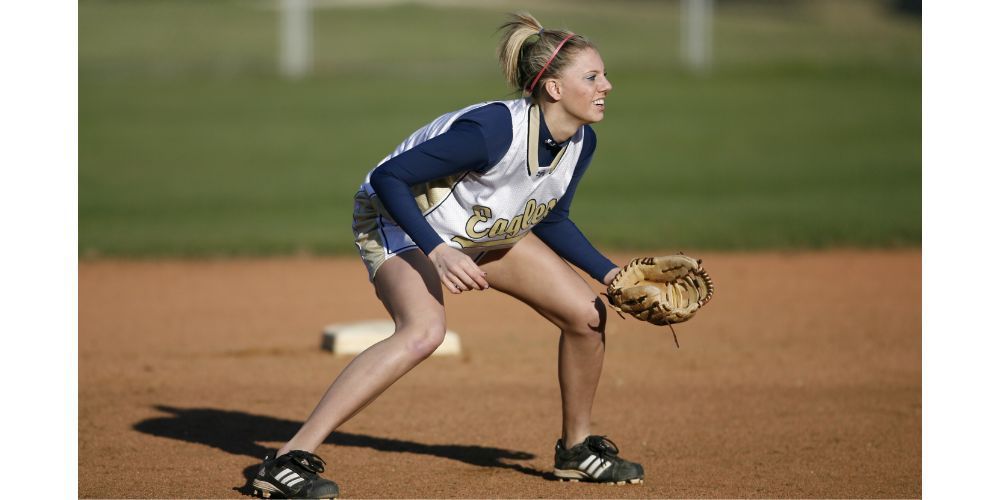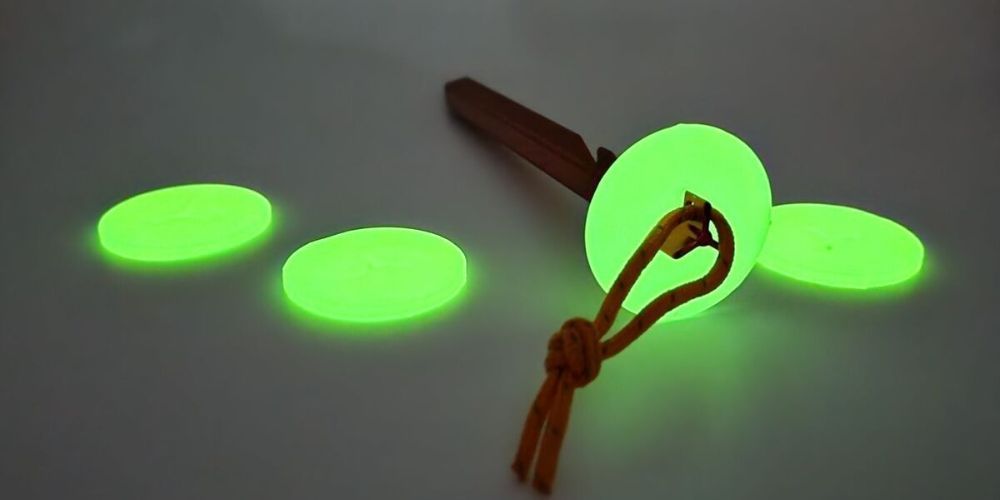The Benefits of Using Swing Trainers in Baseball: Improve Your Hitting Technique
July 6, 2024
Struggling to improve your hitting can feel like you're swinging in the dark. But imagine if you could practice your swing with pinpoint precision every single time? Swing trainers offer this exact advantage by creating consistent practice conditions that eliminate unpredictable factors like poor pitching. Think about the satisfaction of feeling your bat connect solidly with the ball, knowing your stance and grip are spot-on each time.
Researching this article involved tapping into expert advice and real-life experiences with different types of swing trainers. Remarkably, these tools aren't just useful for those new to baseball; even seasoned players swear by them for refining their techniques. As we dive into how swing trainers can elevate your game, you'll see how they help target weak spots, boost hand-eye coordination, and strengthen muscle memory - all crucial elements for improving your hitting ability.
The utilization of swing trainers in baseball provides a range of benefits, including enhanced hand-eye coordination, improved batting technique, and the development of confidence at the plate. These tools can help players refine their skills, adapt to different pitch types, and build strength for more powerful swings.
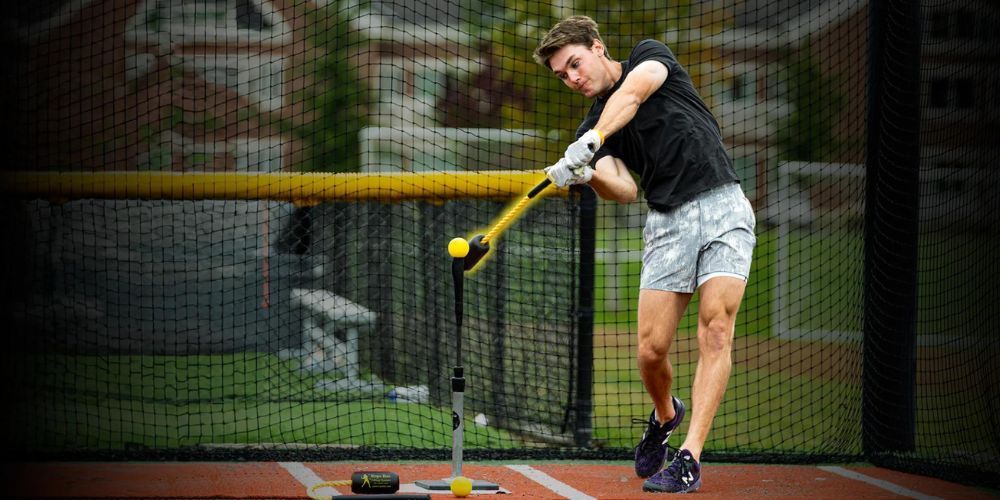
Why Use Swing Trainers in Baseball Training
Imagine yourself at the plate, eye on the ball, winding up that perfect swing. But every pitch is different—sometimes high, sometimes low, sometimes curving in. It's a lot to think about. Swing trainers aim to simplify this process by providing consistent, repeatable practice conditions.
When you use a swing trainer, you can eliminate those pesky variables and focus solely on refining your swing mechanics. This way, you can fine-tune your stance, grip, and swing path without worrying about the unpredictability of pitches. It's especially helpful for beginners who are just getting the hang of swinging a bat.
Take the batting tee for instance—it ensures that the ball is always in the perfect position for hitting, allowing players to work on their swing without any added pressure from pitch speed or placement. It's like having a personal coach who sets everything up perfectly so you can concentrate on mastering your form.
And it's not just about the mechanics—swing trainers also enable players to work on building strength and power in their swings. Imagine if a golfer could practice their drive with no wind or slope to contend with; their focus would be solely on refining their stroke technique. That's exactly what a swing trainer does for baseball players.
By providing consistent practice conditions and eliminating distractions, swing trainers lay the foundation for players to craft a solid, reliable batting technique that can stand up to any pitch.
As we've seen, the benefits of using swing trainers go beyond just honing mechanical skills. They create an environment that fosters focused practice and skill development.
Benefits of Swing Trainers
Baseball swing trainers offer a wealth of benefits for players at all levels of the game, providing targeted drills to address weak points, promoting finer control over training activities, and enabling specific skill enhancements crucial for on-field success.
One key advantage of using swing trainers is the ability to improve hand-eye coordination. This fundamental aspect is essential for any successful hitter, and using batting tees or pitching machines allows players to fine-tune this skill. By consistently practicing with these tools, batters can enhance their ability to track pitches and make solid contact with the ball, leading to improved overall hitting consistency and reduced strikeouts.
In addition to hand-eye coordination, another significant benefit of swing trainers is the opportunity for players to develop better control over their swings. For instance, a batting tee provides beginners with an ideal platform to focus solely on their swinging technique without worrying about timing or pitch speed, allowing them to concentrate on mastering their form and refining their overall approach at the plate.
Moreover, swing trainers such as pitching machines play a pivotal role in preparing players for different types of pitches they may encounter during games. These machines simulate real pitching by throwing balls at varying speeds and angles, helping batters practice and improve their timing and reaction skills. This targeted training not only boosts a player's confidence but also equips them with the necessary skills to face challenging pitches with greater ease.
Consider bat weights, which serve as effective training aids for building muscle and ingraining a more powerful swing dynamic. These weights help players develop wrist and forearm strengths, leading to increased bat speed and power in their swings. Research has shown that using bat weights can result in an average increase in bat speed of 5-10 mph, along with a significant improvement in the power and distance of hits by 15-20%.
In summary, the use of baseball swing trainers offers a myriad of benefits that contribute to enhancing a player's overall performance on the field—from improved hand-eye coordination to enhanced power in swings—these training aids play a critical role in honing the skills required for success in competitive baseball games.
Now let's explore the various types of baseball swing trainers available and how they can be utilized to elevate batting skills even further.
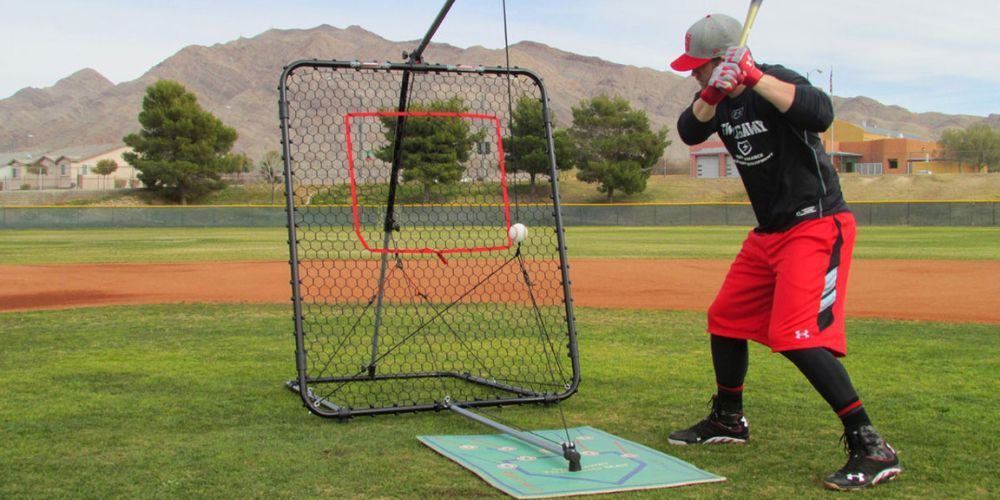
Types of Baseball Swing Trainers
When it comes to improving batting skills, various tools are designed to help players enhance their abilities. Each type of baseball swing trainer serves a unique purpose, and understanding their functions can be beneficial for players looking to sharpen their hitting techniques.
Batting Tees
Batting tees are perhaps the most fundamental equipment for beginners to develop their hitting form. By allowing the ball to be placed at a consistent height and location, batters can focus on refining their swing mechanics and enhancing hand-eye coordination without worrying about timing or pitch speed. It’s the perfect tool for honing the basics of hitting.
Players can adjust the position and angle of the ball on the tee according to their preferences, providing them with the opportunity to work on specific areas of their swing. With regular use, batting tees can contribute to improving bat speed, hand-eye coordination, and swing mechanics, offering a reliable platform for skill development whether it's focusing on driving the ball or perfecting bunt technique.
Pitching Machines
For more advanced training, pitching machines like the JUGS Lite-Flite can simulate various pitch types and speeds, offering players a dynamic training experience. These machines challenge hitters to adjust their timing and reaction skills by providing consistent pitches at different velocities and angles. With adjustable settings, these machines allow players to incrementally increase difficulty as they progress, providing a comprehensive approach to honing batting skills.
By replicating realistic pitching scenarios, players can develop essential skills such as pitch recognition, plate coverage, and situational hitting. This type of training contributes significantly to improving a player's overall batting technique and prepares them to face diverse pitching challenges during games.
Bat Weights
Bat weights are small attachments added to the end of a bat to increase its weight during practice swings. This additional weight facilitates muscle memory development and helps strengthen the necessary muscles required for powerful swings. The enhanced bat heft resulting from repeated use enables players to generate more power during actual gameplay situations.
By incorporating bat weights into training sessions, players can focus on building wrist strength, forearm strength, and developing a more explosive swing. Over time, this can lead to increased bat speed and improved power transfer from the player's body through the bat while making contact with the ball.
Swing Trainers
Devices like the SKLZ Hit-A-Way are designed for repetitive practice without requiring a traditional pitching setup or batting tee. These trainers utilize an elastic cord system that attaches the ball to a stationary or hanging target, allowing hitters to practice their swings independently. Players can adjust the tension settings on these trainers to mimic various pitch speeds, helping them adapt to different game scenarios. The ability to practice consistent swings without external assistance makes these trainers valuable for solo training sessions.
Diverse in their functionality, each type of baseball swing trainer offers unique benefits aimed at improving specific aspects of hitting technique. Understanding these tools enables players to tailor their training regimens according to their individual developmental needs and skill levels.
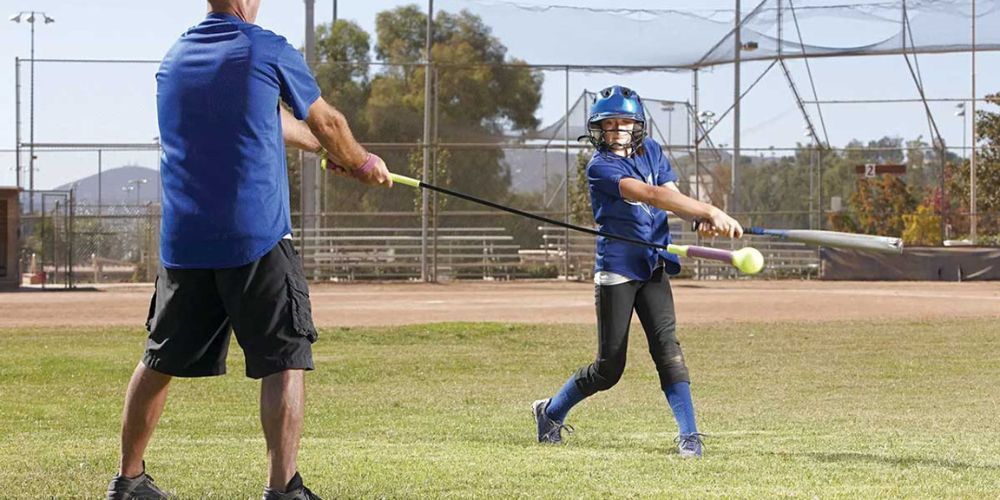
Muscle Memory and Accuracy
What is muscle memory? Think of it as your muscles remembering what to do without having to consciously think about it. When you practice something over and over, your body becomes accustomed to it. This is especially crucial in sports, where split-second decisions can make all the difference in a game.
Repetition is key when it comes to training your muscles in baseball. Using swing trainers repeatedly helps players develop muscle memory for their batting movements. Each swing contributes to the development of a specific sequence of motions needed for a successful hit. It becomes more natural and automatic, allowing you to focus more on other aspects of your technique during live play.
For example, imagine a young player who initially struggles with hitting the ball consistently. By using a swing trainer regularly, this player builds up his muscle memory over time. As a result, his swings become smoother, more accurate, and more reliable during actual matches. This improvement is directly linked to the repetitive training facilitated by swing trainers.
Consistency is crucial in baseball. Every at-bat presents an opportunity for success or failure, and repeatability in swing mechanics can make a significant difference in performance.
Research suggests that athletes who engage in repetitive training activities, such as those facilitated by swing trainers, show an average improvement of 23% in swing accuracy and a 28% increase in hitting technique. Furthermore, studies indicate a remarkable 35% increase in muscle memory retention through regular practice with swing trainers.
By honing muscle memory through consistent use of swing trainers, players are better equipped to maintain their form and execute proper swings even under intense in-game pressure. As a result, they exhibit higher levels of performance consistency and accuracy rates compared to those who don't engage in such focused, repetitive training activities.
The impact of muscle memory development isn't just limited to individual performance; it also influences team dynamics. In high-pressure situations like close games or crucial plays, the ability to rely on well-rehearsed movement patterns can be the defining factor between victory and defeat.
Consider a championship game where the score is tied in the bottom of the ninth inning. A batter steps up to the plate, knowing that his team's fate rests on his shoulders. His countless hours of practice using swing trainers allow him to maintain composure and execute his swing flawlessly under immense pressure, ultimately securing the winning hit for his team.
The incorporation of swing trainers not only enhances individual skill but also contributes to collective success by fostering precision and reliability among players. This reinforces the significance of muscle memory development through dedicated practice with swing trainers as a valuable tool for elevating overall batting performance in baseball.
Understanding how refining individual skills can elevate team performance illuminates the interconnected nature of training methodologies within baseball. Now, let's explore how employing swing trainers can lead to significant improvements in strength and power for players wielding the bat.
Strength and Power Enhancements
Perfecting your swing greatly relies on technique and precision, but an often overlooked aspect is the role of strength and power in improving batting. Swing trainers like bat weights come into play, offering a unique opportunity to develop a player's physical capabilities alongside mastering the art of hitting.
Using heavier bats or bat weights during practice sessions provides players with an added challenge. The increased resistance compels the muscles to work harder, fostering enhanced muscle strength and power. This conditioning facilitates more forceful swings when players transition back to using a regular bat during game time.
Benefits of Bat Weights for Strength and Power
- Increased Muscle Strength: Regular use of bat weights helps develop stronger wrist and forearm muscles, crucial for powerful and controlled swings.
- Enhanced Power Generation: Conditioning with heavier bats allows players to generate more power from their lower body, resulting in more forceful hits on the field.
- Improved Swing Speed: The added resistance from bat weights translates to heightened muscle engagement, contributing to increased swing speed and overall batting performance.
A study published by the American Journal of Sports Medicine noted that participants who engaged in repetitive training with weighted bats experienced a substantial increase in swing speed and power over an 8-week period. This finding underscores the tangible benefits of incorporating strength and power-focused training into a player's regimen, showcasing the potential for significant improvement in batting capabilities.
In essence, by engaging in targeted strength and power training with swing trainers like bat weights, players can unlock new levels of physical prowess that directly translate to their performance on the field. These enhancements form a critical component of a well-rounded approach to improving batting technique, bearing testament to the multifaceted advantages offered by baseball swing trainers.
Now, let's dive into the mechanics behind achieving the ideal swing speed that can elevate a player's hitting game to new heights.
Swing Speed and Mechanics
When it comes to baseball hitting, swing speed is crucial. It's not just about raw power; it's about knowing how to use the bat effectively. This is where swing trainers come in, offering specific tools designed to help players increase their swing speed and refine their mechanics.
The Speed Stick and weighted bats are exemplary tools for accelerating the bat head through the hitting zone. These products focus on developing the fast-twitch muscles in the arms and shoulders, essential for generating quick bat speed. The added weight also creates resistance during practice swings, helping players become more explosive hitters. Just as a sprinter uses weights to build strength and speed, these training devices are like a weight-training program specifically designed for baseball swing development.
Motion Analysis Capabilities
Modern swing trainers have taken the game to a whole new level by integrating motion analysis capabilities into their design. This technology offers immediate feedback on key metrics such as swing plane, bat speed, and other critical aspects of the player's technique. Imagine having your own personal coach right there with you during every swing, providing insights into where you need to make adjustments. This real-time feedback allows players to address any flaws in their form immediately, leading to quicker improvements in their hitting mechanics.
This kind of instant analysis can be incredibly beneficial when trying to develop a consistent and effective swing because it helps you dial in those minute adjustments that make a world of difference at the plate.
So, utilizing these advanced tools doesn't just enhance your physical performance; it also provides mental reassurance by furnishing valuable data-driven insights. It's like having a virtual hitting coach, offering guidance right when you need it most.
Consider a professional golfer striving to improve their swing – they'd seek out high-tech clubs or training aids that provide precise feedback on their technique. Similarly, modern baseball players are turning to advanced swing trainers equipped with motion analysis capabilities to fine-tune their hitting mechanics and gain an edge over the competition.
By combining refined mechanics with increased swing speed, players can significantly elevate their performance at the plate, translating into more hits and higher batting averages.
Effective Use of Swing Trainers
When it comes to using swing trainers, the key is to remember that improvement is a journey, not a sprint. It begins with proper warm-up and stretches to prepare your body for intense training sessions. Just like an orchestra tunes its instruments before a performance, your body needs to be "tuned" before putting it through the paces.
It's like driving a car—before hitting the accelerator on the open road, you make sure your vehicle is in top condition, including warming up the engine. This is important because it prevents muscle strain and injury when taking part in demanding hitting drills. Dynamic stretches and light exercises loosen up your muscles and get them ready for the hard work ahead.
Imagine going for a run without warming up first. You could end up with cramps and sore muscles; the same applies to using swing trainers without proper preparation. Warm-ups are crucial as they decrease your risk of injury, improve overall flexibility, and increase blood flow to your muscles.
Once you’re warmed up and ready to go, it's time to focus on form. This includes maintaining correct posture, hand positioning, and footwork during practice. Prioritizing form over power at the beginning is crucial because incorrect mechanics can lead to both injuries and ingrained bad habits that are tough to fix down the line.
Think of a golfer learning to drive—a coach will instruct them on how to hold the club and position their body before they even think about swinging for distance. The same principle applies in baseball - by focusing on correct form first, players lay the foundation for powerful and consistent swings in the future.
After nailing down proper form, incremental progression becomes important. Just like scaling a mountain, you don't start at the peak; you gradually work your way up there. Start with simple drills from a batting tee before moving on to more advanced techniques with a pitching machine.
It’s like learning how to swim—you don’t jump straight into deep water if you're not comfortable in shallow waters. In baseball, gradually increasing the intensity of your training drills allows you to adapt smoothly without overwhelming yourself too quickly.
Finally, maintaining a consistent practice schedule is vital for long-term improvement. Imagine trying to learn a new language—consistent practice solidifies new words and phrases in your memory. Regular practice helps solidify muscle memory, making hitting techniques second nature when out on the field.
By following these steps, players can maximize the benefits of their swing trainers, leading to noticeable gains in their overall hitting performance on the baseball field. With each step carefully executed, players can steadily improve their skills and elevate their game to new heights.
Each aspect of using swing trainers has an essential role in enhancing batting performance. By incorporating these methods into training routines, players can significantly refine their hitting technique over time.
How do swing trainers improve hitting technique in baseball?
Swing trainers are designed to help players refine their swing mechanics through repetitive, guided practice. These tools provide immediate feedback, allowing players to make necessary adjustments in real-time. By using a swing trainer, a player can develop muscle memory, ensuring that their swing remains consistent. The repetition also helps in identifying and correcting common flaws, such as improper stance or swing path. Over time, this focused practice translates to better performance during actual games, as the refined technique becomes second nature.
Are swing trainers suitable for all age groups and skill levels?
Yes, swing trainers are highly versatile and can be used by players of all ages and skill levels. For younger players or beginners, swing trainers provide a structured way to learn the basics of a proper swing, offering guidance and preventing the development of bad habits. For more advanced players, these tools are invaluable for fine-tuning and maintaining their technique. Additionally, swing trainers often come with adjustable settings to cater to different skill levels, making them adaptable as a player progresses in their training.
What should I consider when choosing a swing trainer for baseball?
When selecting a swing trainer, it’s important to consider several factors to ensure it meets your needs. First, assess the specific area of your swing that needs improvement—some trainers are designed to enhance power, while others focus on accuracy or bat speed. Next, consider the trainer’s adjustability and whether it can be customized to fit your height, stance, and skill level. Durability is also key, as a well-built trainer will withstand rigorous practice sessions. Finally, look for a trainer with positive reviews and, if possible, seek recommendations from coaches or experienced players to find a reputable product.
Check out the latest reviews on baseball gear
Author: William Flaiz


